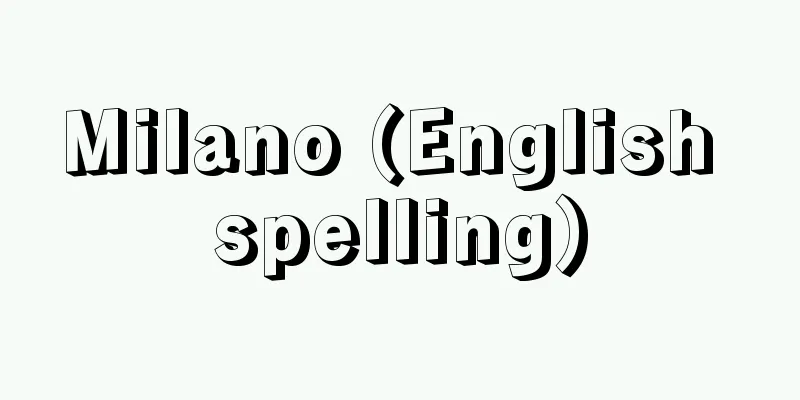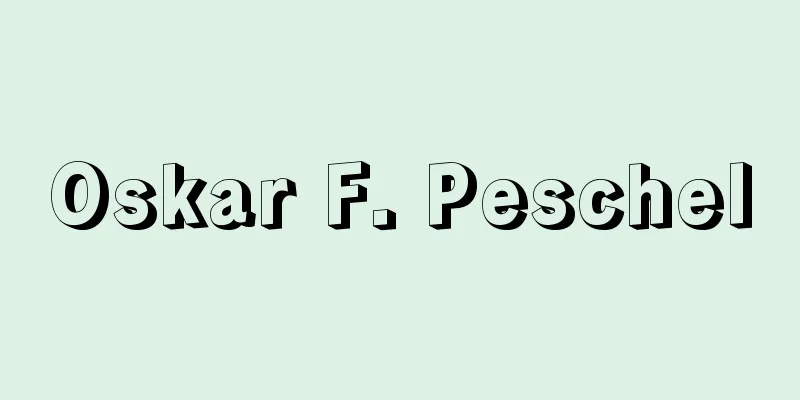Milano (English spelling)

|
Milan is the capital of Lombardy, a region in northwest Italy. Its English and French names are Milan. It has an area of 182 square kilometers and a population of 1,182,693 (2001 census estimate). It is the largest industrial city in Italy and is the country's "economic capital." It is located in the center of the Lombardy plain, at an altitude of 122 meters along the Olona and Lambro rivers. It is a key transportation hub where roads crossing the Alps, such as the Simplon Pass, the Splügen Pass, and the San Gothardo Pass, converge, and it is also connected by highways to major cities such as Rome (the "Road of the Sun"), Turin, Genoa (the "Highway of Flowers"), and Venice. [Kenichi Sakai] IndustryAlthough Milan's economic base was based on the rich agricultural production in the plains of Lombardy and raw silk produced in the hills, it was still a commercial city at the time of national unification (1861). However, between 1870 and 1920, it transformed into a first-class industrial city with the founding and development of companies such as Cantoni (cotton), Pirelli (rubber), Edison (electricity), Breda (machinery), Falck (steel), and Alfa Romeo (automobiles). Currently, a wide variety of industrial activities are being carried out in the city, including machinery, steel, chemicals, pharmaceuticals, petrochemicals, rubber, electricity, and textiles. With the exception of Fiat in Turin, most of Italy's large companies have their headquarters in Milan, and about 40% of the capital of joint-stock companies nationwide is concentrated in this area. However, the actual production mechanisms of large companies have tended to disperse to the outskirts of the city, especially after the Second World War, and most of those that remain in the city are small and medium-sized production units. Therefore, in the case of Milan, it can be said that it forms one large industrial area including the extensive surrounding area. The population, which was only about 240,000 in 1861, peaked at 1,745,220 in 1973 and has been on a downward trend ever since. [Kenichi Sakai] Cultural FacilitiesMilan, a modern commercial and industrial city, is also a city that is alive with culture and tradition, surrounded by many historical buildings, museums, art galleries, and universities. The Duomo (Cathedral) in the center of the city is a representative Gothic building in Italy, whose construction began in 1386 at the request of Gian Galeazzo Visconti of the Visconti family and was finally completed in 1809 by order of Napoleon. The Renaissance-style Santa Maria delle Grazie Church (c. 1464-1490) houses Leonardo da Vinci's immortal masterpiece, the mural "The Last Supper." The Romanesque-style Sant'Ambrogio Church (rebuilt in the 11th century), founded by Saint Ambrose, who became Archbishop of Milan in 374 and is still the city's patron saint, and where his remains are enshrined, is also famous. Other must-see buildings include Sforza Castle, built by Milan's Renaissance ruler Francesco Sforza (Duke of Milan 1450-66) and now a museum; the internationally renowned La Scala opera house (1776-78); and the glass-roofed Vittorio Emanuele II Arcade (1865-77), which connects Piazza del Duomo with the square in front of La Scala. Among the art museums, the Ambrosiana Museum, which has a collection of masterpieces from the Renaissance, and the Brera Art Gallery, which has a collection of Lombard and Venetian paintings from the 15th to 18th centuries, are well known. Universities include the Bocconi School of Commerce (1902), the Catholic University (1920), and the University of Milan (1924). An international trade fair is held every April. [Kenichi Sakai] historyIn 222 BC, Rome conquered the indigenous Celts and gained Milan. In the 3rd century AD, it became an important military base to deal with the growing threat of the Germanic peoples, and at the end of the same century, with the reforms of Emperor Diocletian, it became the administrative center of the western part of the Empire. It was the base of the Western Emperors until 404, when the administrative power was transferred to Ravenna. After St. Ambrose became Archbishop of Milan (374) and refuted the Arian heresy, the Archbishop of Milan had authority equal to that of the Archbishop of Rome. After the 5th century, the city was plagued by invasions by foreign tribes, but the Archbishop of Milan gradually gained secular power and became a great feudal lord during the period of the Ottonian Emperors (late 10th century). In the 11th century, the archbishop's vassals, who became independent from the archbishop's power with the support of the emperor, became urban aristocrats and temporarily came into conflict with the urban class, which was becoming more powerful with the development of commerce and industry, but in 1067 the two groups jointly formed a comune (urban community), and the archbishop's power was reduced. Holy Roman Emperor Frederick I (Redbeard), who aimed to rule Italy, was defeated by the Lombard League, and in 1183 the Treaty of Constance was concluded between the two, but the Milanese urban community gained extensive autonomy through this treaty. Milan was already a major power in Lombardy, and prospered through the production of woolen textiles and weapons backed by the mines of the Alps. The defeat of Emperor Frederick II in 1237 led to further intensification of the conflict between the traditional city nobility and the emerging merchants and manufacturers. In 1277, the Visconti family, representatives of the former, gained power, and in 1395, when Gian Galeazzo of the Visconti family became duke, the Duchy of Milan was established. The Duchy became a major power in Italy and a center of Renaissance culture. The Sforza family succeeded the duchy to the Visconti family, but in 1515 they were forced to cede the duchy to the powerful French king Francis I. Emperor Charles V (Carlos I), who defeated Francis I in the Italian Wars, acquired Milan in 1535 and eventually gave it to his son Philip II in 1540. Milan was subject to harsh Spanish rule thereafter, and its political and economic importance gradually declined. In 1714, it became part of Austria in the War of Spanish Succession, and its economy developed considerably in the second half of the 18th century due to its Enlightenment politics. After 1796, Milan was ruled by Napoleon I, but in 1815 it became part of the Kingdom of Lombardy and Veneto under Austrian rule, and in 1859 it was annexed to the Kingdom of Savoy (later the unified Kingdom of Italy). Milan, which achieved the Industrial Revolution early in Italy, remains a major economic center in the country to this day. [Saito Hiromi] [References] | |It is a symbol of Milan and a representative Gothic building in Italy. Construction began in 1386 and was completed in 1809 by order of Napoleon. In front of the cathedral is Duomo Square. Milan, Italy ©Shogakukan "> Milan Cathedral A Gothic church built in the late 15th century. Later, a Renaissance-style apse with a cupola was added by Bramante, a leading Renaissance architect. Leonardo da Vinci's "The Last Supper" is painted on the wall of the former dining hall. Part of the World Heritage Site "Church and Dominican Monastery of Santa Maria delle Grazie, home of Leonardo da Vinci's "The Last Supper"" (Italy, registered in 1980) Milan, Italy ©Shogakukan "> Church of Santa Maria delle Grazie This opera house was built on the site of the Church of St. Maria alla Scala. It opened in 1778 and is Italy's leading opera house. The current building was rebuilt between 1946 and 1948 after being damaged during World War II. Milan, Italy ©Shogakukan "> La Scala A magnificent arcade with a glass ceiling. Built in 1877, it connects Piazza del Duomo with the square in front of La Scala. It is lined with fashion brand stores, restaurants, cafes, and more. Milan, Italy ©Shogakukan "> The Vittorio Emanuele II Arcade (1811-1865) is a 19th-century building… Source: Shogakukan Encyclopedia Nipponica About Encyclopedia Nipponica Information | Legend |
|
イタリア北西部、ロンバルディア州の州都。英語およびフランス語名ミランMilan。面積約182平方キロメートル、人口118万2693(2001国勢調査速報値)。イタリア最大の工業都市で、同国のいわば「経済的首都」である。ロンバルディア平原の中央部、オローナ川とランブロ川に沿った標高122メートル地点に位置する。シンプロン峠、シュプリューゲン峠、サン・ゴタルド峠などを通るアルプス越えの道路が集中する交通の要衝で、ローマ(「太陽道路」)、トリノ、ジェノバ(「花の高速道路」)、ベネチアなどの大都市とも高速道路によって結ばれている。 [堺 憲一] 工業ロンバルディアの平野部における豊かな農業生産や、丘陵地帯で生産される生糸を経済的基盤としながらも、国家統一(1861)期のミラノは依然として商業都市の域を出なかった。ところが、1870年から1920年にかけて、カントーニ(綿業)、ピレッリ(ゴム)、エジソン(電力)、ブレダ(機械)、ファルク(製鉄)、アルファ・ロメオ(自動車)などの企業の創設・発展をみ、第一級の工業都市に転身した。現在は機械、製鉄、化学、薬品、石油化学、ゴム、電気、繊維などきわめて多様な工業活動が展開している。トリノにあるフィアット社を除けば、イタリアの大企業のほとんどが本社をミラノに置いており、全国の株式会社の資本金の約40%がこの地に集中している。もっとも、大企業の実際の生産機構については、とくに第二次世界大戦後は市の周辺部に分散する傾向がみられ、市内に残るものの多くは中小規模の生産単位である。それゆえ、ミラノの場合は広範囲な周辺地域を含めて一つの大工業地帯を形成しているといえる。1861年には約24万人にすぎなかった人口は、1973年にピークの174万5220人を記録し、以後減少傾向を続けている。 [堺 憲一] 文化施設近代的な商工業都市ミラノは、また多くの歴史的建築物、博物館、美術館、大学などに囲まれた文化と伝統が息づく町でもある。市の中心部にあるドゥオモ(大聖堂)は、1386年にビスコンティ家のジャン・ガレアッツォ・ビスコンティの意向を受けて着工され、1809年にナポレオンの命令でようやく完成をみたイタリアにおけるゴシック様式の代表的建築物である。ルネサンス様式のサンタ・マリア・デッレ・グラツィエ教会(1464~90ころ)には、レオナルド・ダ・ビンチの不朽の名作である壁画『最後の晩餐(ばんさん)』が収められている。374年にミラノの大司教となり、いまでも同市の守護聖人となっている聖アンブロシウスによって創設され、彼の遺骨が祀(まつ)られているロマネスク様式のサンタンブロージョ教会(11世紀に再建)も名高い。ルネサンス期ミラノの支配者フランチェスコ・スフォルツァFrancesco Sforza(ミラノ公1450~66)によってつくられ、現在では博物館となっているスフォルツァ城、国際的に有名なオペラの殿堂スカラ座(1776~78)、ドゥオモ広場とスカラ座前の広場を結び、ガラス張りの天井を有するビットリオ・エマヌエレ2世アーケード(1865~77)などもみるべき建築物である。美術館では、ルネサンス時代の名画を集めたアンブロジアーナ絵画館、とくに15~18世紀のロンバルディア派やベネチア派の絵画などを収めたブレラ美術館が知られる。大学にはボッコーニ商科大学(1902)、カトリック大学(1920)、ミラノ大学(1924)などがある。毎年4月に国際見本市(いち)が開催される。 [堺 憲一] 歴史紀元前222年、ローマは先住のケルト人を征服し、ミラノを得た。紀元後3世紀、ゲルマン人の脅威の増大に対処する重要軍事拠点となり、同世紀末にディオクレティアヌス帝の改革で帝国西部の行政中心地となった。404年の行政府のラベンナ移行まで西帝の本拠であった。聖アンブロシウスがミラノ大司教に就任し(374)、アリウス派異端を反駁(はんばく)してから、ミラノ大司教はローマ大司教にも劣らぬ権威をもった。5世紀以後、異民族の侵入に悩まされたが、こうしたなかでミラノ大司教はしだいに世俗権力を獲得し、オットー諸帝時代(10世紀後半)には大封建領主となった。11世紀、皇帝の援助で大司教の権力から独立化した大司教の封臣は都市貴族となり、商工業の発展で有力化していた市民層と一時対立したが、1067年この両者が共同でコムーネ(都市共同体)を形成し、大司教の権力は後退した。 イタリアの支配を目ざした神聖ローマ皇帝フリードリヒ1世(赤髯(あかひげ)王)はロンバルディア都市同盟に敗北し、1183年両者間にコンスタンツの和約が成立したが、ミラノ都市共同体はこの和約で広範な自治権を得た。すでにミラノはロンバルディアの一大勢力であり、毛織物やアルプス諸鉱山を背景にした武具の生産で繁栄していた。1237年皇帝フリードリヒ2世に対する敗北が契機となり、従来の都市貴族と新興の商・工業者との対立がいっそう激化した。1277年前者の代表ビスコンティ家が政権を獲得し、やがて1395年、同家のジャン・ガレアッツォの公位獲得によりミラノ公国が成立した。公国はイタリアの一大勢力となり、ルネサンス文化の一中心地となった。ビスコンティ家にかわりスフォルツァ家が公位を継いだが、1515年強大なフランス王フランソア1世に公国の譲渡を余儀なくされた。 イタリア戦争でフランソア1世に勝利した皇帝カール5世(カルロス1世)は、1535年ミラノを獲得し、やがて1540年息子フェリペ2世に与えた。以後ミラノはスペインの過酷な支配を受け、その政治的・経済的重要性はしだいに減少した。1714年スペイン継承戦争でオーストリアに帰属し、18世紀後半、その啓蒙(けいもう)主義的政治により経済がかなり発展した。1796年以後ミラノはナポレオン1世の支配を受けたが、1815年オーストリア支配下のロンバルド・ベネト王国の一部となり、1859年サボイア王国(後の統一イタリア王国)へ併合された。イタリアでいち早く産業革命を達成したミラノは現在に至るまで同国の一大経済中心地となっている。 [斉藤寛海] [参照項目] | |ミラノの象徴であり、イタリアにおけるゴシック様式を代表する建築物。1386年に起工され、1809年にナポレオンの命により完成をみた。聖堂前はドゥオモ広場。イタリア ミラノ©Shogakukan"> ミラノ大聖堂 15世紀後半に建築されたゴシック様式の教会。のちにルネサンス期の代表的建築家ブラマンテにより、クーポラ(円蓋)をもつルネサンス様式の後陣が増築された。かつての食堂の壁には、レオナルド・ダ・ビンチの『最後の晩餐』が描かれている。世界文化遺産「レオナルド・ダ・ビンチの『最後の晩餐』があるサンタ・マリア・デッレ・グラツィエの教会とドメニコ会修道院」の一部(イタリア・1980年登録) イタリア ミラノ©Shogakukan"> サンタ・マリア・デッレ・グラツィエ教会 聖マリア・アラ・スカラ教会の跡に建てられた歌劇場。1778年開場。イタリアを代表するオペラ・ハウスである。現在の建物は、第二次世界大戦で損傷したのち、1946~48年にわたり再建された。イタリア ミラノ©Shogakukan"> スカラ座 ガラス張りの天井を有する壮麗なアーケード。1877年の建設で、ドゥオモ広場とスカラ座前の広場を結ぶ。ファッション・ブランド店、レストランやカフェーなどが軒を連ねる。イタリア ミラノ©Shogakukan"> ビットリオ・エマヌエレ2世アーケード(… 出典 小学館 日本大百科全書(ニッポニカ)日本大百科全書(ニッポニカ)について 情報 | 凡例 |
>>: Milanese (English spelling)
Recommend
Tsu
[1] 〘noun〙① A place where ships can anchor, such a...
Tokyo Rose - Tokyo Rose (English spelling)
1916 - American announcer. Also known as Iva Togu...
Gold and silver inflow and outflow
...A general term for lawsuits related to monetar...
Differential thermal analysis
A general term for research methods and thermal an...
Alphabet Song - Alphabet Song
… According to Kabbalistic mysticism, the Western...
Hymenopodidae
…They are highly predatory even from the time the...
Dolby system
…Even if there are slight differences in the leve...
Shared device - Kyoyouki
...Here, we will only look at tableware in the na...
Mountain well - Yamanoi
Haikai seasonal collection. Written by Kitamura Ki...
Shirataki - Shirataki
The former name of the village (Shirataki Village...
Bellini, G. (English spelling) BelliniG
…For two generations, father and son played a lea...
Vote counting manager
...In an election, the ballot counting officer op...
Ainu Trade - Ainu Station
… [Ezo Development] The development of Ezochi in ...
Wang Guai (English spelling)
A Chinese painter of the early Qing dynasty. His b...
Commentary school - Chinese
A school of Roman law studies active in Italy from...









